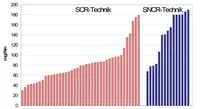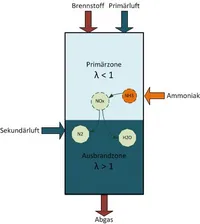Robust NOx Reduction
"Robust and efficient NOx reduction with ammonia injection in a reducing flue gas atmosphere."
Motivation
During the combustion process, both fuel and combustion air produce partially environmentally neutral, low-energy products, but also environmentally damaging pollutants. One of these harmful pollutants is nitric oxide. In Germany, the acceptable amount of emissions is dictated by the Federal Emissions Protection Law (Blm-SchG). Starting in 2013, the annual limit of NOx emissions for existing waste combustion facilities (MVAs) was set at 50 MW to 100 mg/Nm3. In order to adhere to this limit, not only technical combustion measures, but also NOx mitigation methods are being implemented. In waste combustion facilities, both Selective Catalytic Reduction (SCR) and Selective Non-Catalytic Reduction (SNCR) are being implemented. Most of the facilities with SCR systems are meeting the new limit. On the other hand, only a quarter of the facilities using SNCR systems are reaching emission values under 100 mg NO2/Nm3 (see diagram to the right). It is therefore in the best interest of the operators of these facilities to improve SNCR technology.
Project Goals
This project, funded by the Bavarian Research Foundation (BFS), aims to determine the potential and limitations of the SNCR process, in order to reduce the emissions of waste combustion facilities. The research focuses on ammonia injection in substoichiometric zones, which has long been viewed as a promising method, but has not yet been applied in industrial facilities. To this end, tests will be run using the entrained flow reactor at the Institute for Energy Systems (see diagram 2). All investigations will be accompanied by CFD simulations. In addition to this, test campaigns at large-scale waste combustion facilities are on the agenda, to evaluate the applicability of the method in practice. The industrial partner in this project is the Martin GmbH for environmental and energy technology.
For more information, contact: Kristina Speth

